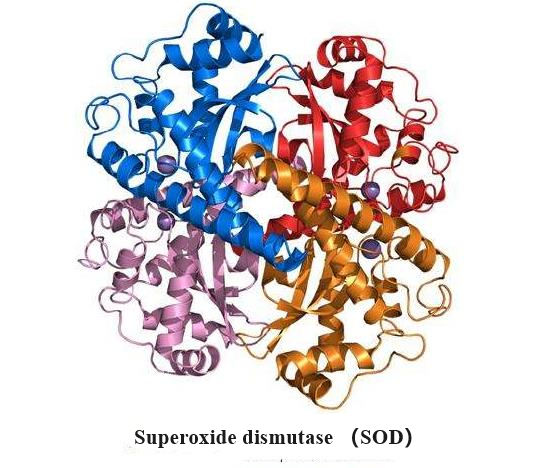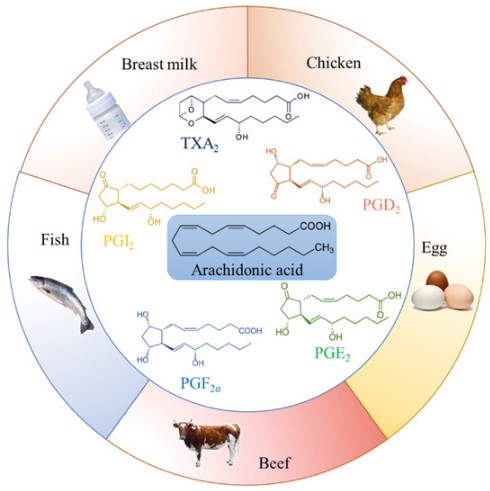Therapeutic potentials of superoxide dismutase
Dec 22,2023
Introduction of Superoxide dismutase
Superoxide dismutases (SODs) constitute a very important antioxidant defense against oxidative stress in the body. The enzyme acts as a good therapeutic agent against reactive oxygen species-mediated diseases. It can be used as an anti-inflammatory agent and also prevents pre-cancerous cellular changes. SOD is used as an anti-aging ingredient and antioxidant in cosmetics and personal care products because of its ability to reduce free radical damage to the skin, thus preventing wrinkles, fine lines, and age spots. It also aids in wound healing, softening of scar tissue, protection from UV rays, and reduces other signs of aging.

SOD has been reported to have important links to a variety of human health problems, including erythrocyte-related diseases, cystic fibrosis (CF), post-cholecystectomy pain syndrome, malignant breast disease, steroid-sensitive nephrotic syndrome, amyotrophic lateral sclerosis, neuronal apoptosis, AIDS, and cancer. In addition, some researchers have suggested a strong association between SOD activity and Alzheimer's disease. Treatment with SOD has also been reported to help recovery from mustard gas burns. The SOD enzyme has been found to be very effective in many animal models suffering from myocardial ischaemia-reperfusion injury, inflammation and cerebral ischaemia-reperfusion injury, etc. SOD mimetics (small-molecule catalytic antioxidants) offer the potential for treating oxidative stress-induced diseases.
SOD and Cancer
SOD, being a key cellular antioxidant, is highly responsible for the elimination of O2-. Many studies have revealed the critical role of oxidative stress in carcinogenesis. Reduced activities of Cu, Zn-SOD and Mn-SOD have been reported in cancer cells. Normalisation of SOD levels contributes to the reversal of some cancer cell phenotypes. In addition, Cu, Zn-SOD has been shown to be a new therapeutic target for the treatment of multiple myeloma. On the contrary, the invasive and migratory activity of pancreatic cancer is promoted by SOD through activation of the H2O2/ERK/NF-κB axis. It has recently been shown that a potent SOD mimetic, MnTnBuOE-2-PyP(5+), enhances carbenoxolone-mediated TRAIL-induced apoptosis in the most malignant tumor of the brain.
SOD and inflammatory diseases
SOD may serve as an inhibitory agent of neutrophil-mediated inflammation and may stand for a novel therapeutic approach for the ROS-dependent tissue damage induced by neutrophils through several mechanisms. Preclinical studies with bovine Cu, Zn-SOD showed encouraging results for its use as a human therapeutic agent in acute and chronic inflammatory conditions, including dermatosis due to burn and wound injury. Extracellular SOD, Mn-SOD and Cu, Zn-SOD have been described as potential inhibitor of inflammation by various reporters.
SOD and Diabetes
Treatment with SOD has experimentally been shown to reduce liver oxidative stress in diabetic animals. SOD mimetic (Mn[II][pyane] Cl2) has successfully been used to treat diabetes in diabetic rats. Chemically modified SOD (carboxymethylcellulose-SOD and poly methyl vinyl ether-co-maleic anhydride-SOD) was effective in treating diabetes and offers a therapeutic advantage in clinical use. It has been demonstrated that extracellular SOD can act as a therapeutic agent to protect the progression of diabetic nephropathy.
SOD and Neurodegenerative Diseases
Oxidative stress has been shown to be involved in the pathophysiology of several neurodegenerative diseases. The affected regions of patients having Alzheimer's disease (AD) have reduced activity of antioxidant enzymes such as SOD, catalase, and glutathione peroxidase. Familial amyotrophic lateral sclerosis (FALS) is a fatal neurodegenerative disease that leads to the selective loss of motor neurons. Several mutations in Cu, Zn-SOD gene are found to be associated with FALS. In addition, Cu, Zn-SOD is one of the prime victims of oxidative damage to the brain in AD and Parkinson's disease. It has been experimentally demonstrated that overexpression of SOD-2 reduces hippocampal superoxide and hence prevents memory deficits in a mouse model of AD. SOD supplementation showed improvement in mice model of AD. SOD/catalase mimetic EUK-207 exhibited protection against and interruption of progression of amyloid and tau pathology and cognitive decline in a mouse model of AD.
References:
[1] YOUNUS H. Therapeutic potentials of superoxide dismutase.[J]. International Journal of Health Sciences-IJHS, 2018, 12 3: 88-93.
- Related articles
- Related Qustion
- Superoxide dismutase: Reaction, Function and Benefits Jun 18, 2024
Superoxide dismutase (SOD) is a key endogenous and exogenous cellular antioxidant.
- What is the structure of superoxide dismutases? Apr 18, 2024
Superoxide dismutase (SOD) is a group of antioxidant enzymes that catalyze the dismutation of superoxide to oxygen and hydrogen peroxide. SODs are critical antioxidative proteins, protecting the host from oxidative damage.
- Application of Superoxide dismutase Sep 30, 2022
Superoxide dismutase preparations are mainly used in clinical treatment of systemic lupus erythematosus, dermatitis, scleroderma, rheumatoid arthritis, thrombocytopenia and other autoimmune diseases.
Supplementation with pyridoxal 5'-phosphate monohydrate can synthesize neurotransmitters such as dopamine and serotonin, maintaining a healthy nervous system.....
Nov 4,2025Biochemical EngineeringArachidonic acid is an essential fatty acid and a precursor in the biosynthesis of prostaglandins, thromboxanes, and leukotrienes Bosetti.....
Dec 25,2023Organic AcidsSuperoxide dismutase
9054-89-1You may like
Superoxide dismutase manufacturers
- Superoxide dismutase
-

- 2025-12-19
- CAS:9054-89-1
- Min. Order:
- Purity: 0.99
- Supply Ability:
- Superoxide Dismutase
-

- $0.00 / 1KG
- 2025-11-19
- CAS:9054-89-1
- Min. Order: 1KG
- Purity: 95% up by SDS-PAGE analysis
- Supply Ability: 20 tons
- Superoxide dismutase
-

- $6.00 / 1kg
- 2025-07-29
- CAS:9054-89-1
- Min. Order: 1kg
- Purity: 99%
- Supply Ability: 2000KG/Month






